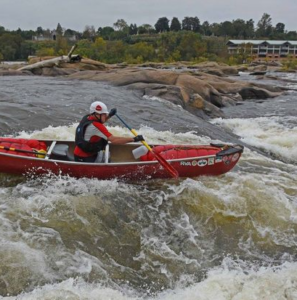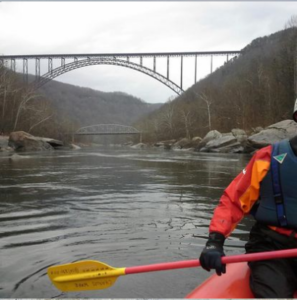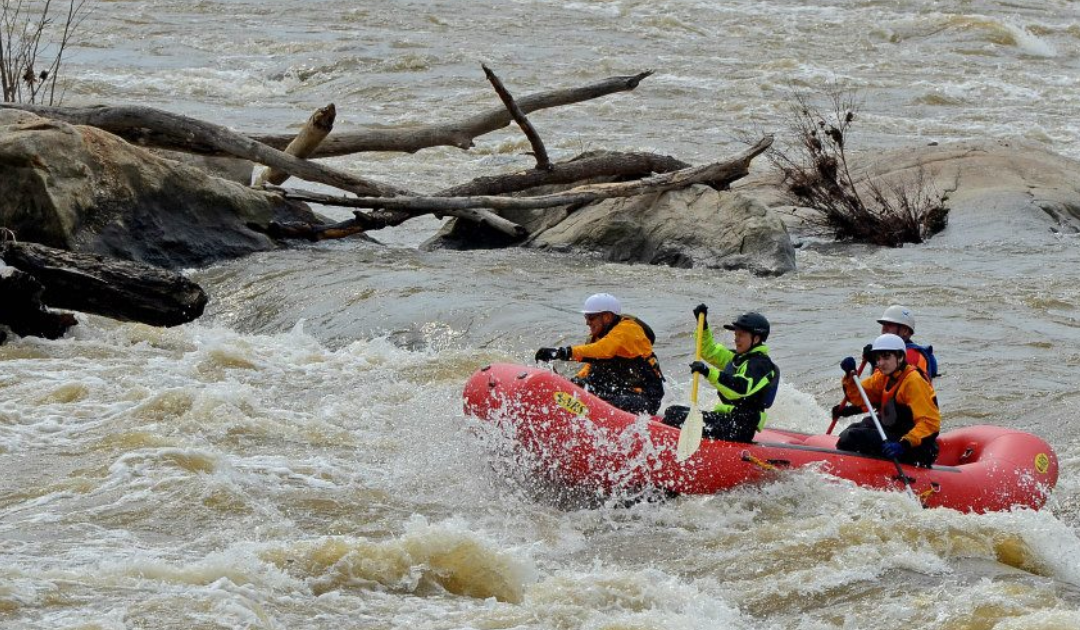by Charles Ware, Richmond, VA
Story prompt: The river is important to me because…
In August 1969, Hurricane Camille tracked into Virginia, dumping perhaps five feet of rain on Nelson County within a 24-hour period. Approximately 160 people died as the result of landslides and flooding in and around Nelson County. My orientation week as a first-year student at the University of Virginia was devoted to searching for those who had vanished into the utter devastation along tributaries of the James, including the Piney and Tye Rivers. What I witnessed has forever been burned into my memory, with communities lost, and a landscape transformed. Later in my first year at UVA, I attended a presentation by the Poet Laureate of the United States, writer James Dickey. He was soon to publish his new novel, which was the basis for the 1972 movie having the same title, “Deliverance.” Upon graduation, I moved to Richmond to commence grad school here. Friends invited me to join them on a tubing trip on the North Anna River, which I followed up on later with a trip down that small river in a rented canoe. As a largely self-taught paddler, I gained confidence on easier runs in the Richmond area, and in 1975 started renting canoes for the more difficult rapids on the lower section of the James within the city.
 Many people are unaware that the Falls of the James were unrunnable prior to the Camille flood of August 1969. Most instream flow in the James at that time was diverted for hydropower generation at four power plants {Byrd Park, Belle Isle, Hollywood, and 12th Street}. There was no flow in the rapids we see today, except for occasional spillage over the intact hydropower dams during high flow periods. The river was heavily polluted until Chesterfield County sewers were connected to a developing Richmond wastewater treatment system. Until 1969, the river was largely lifeless, with hot and stagnant pools blocking any upriver passage of fish. Camille changed that, and by 1975 there was a small cadre of whitewater pioneers to be found on the river. Many belonged to a whitewater club, the Coastal Canoeists {originating in Portsmouth, hence the “coastal” name} that I joined around 1978. One of the pioneering paddlers, Tim McDonald, started a whitewater rafting operation in 1978. Deliverance was about four paddlers who intended to boat a river that was about to be dammed up, but it popularized whitewater boating of all types across the country. Part of this was because there had been a realization that a large percentage of rivers in the country had been fully or partially destroyed for recreational use by hydro development.
Many people are unaware that the Falls of the James were unrunnable prior to the Camille flood of August 1969. Most instream flow in the James at that time was diverted for hydropower generation at four power plants {Byrd Park, Belle Isle, Hollywood, and 12th Street}. There was no flow in the rapids we see today, except for occasional spillage over the intact hydropower dams during high flow periods. The river was heavily polluted until Chesterfield County sewers were connected to a developing Richmond wastewater treatment system. Until 1969, the river was largely lifeless, with hot and stagnant pools blocking any upriver passage of fish. Camille changed that, and by 1975 there was a small cadre of whitewater pioneers to be found on the river. Many belonged to a whitewater club, the Coastal Canoeists {originating in Portsmouth, hence the “coastal” name} that I joined around 1978. One of the pioneering paddlers, Tim McDonald, started a whitewater rafting operation in 1978. Deliverance was about four paddlers who intended to boat a river that was about to be dammed up, but it popularized whitewater boating of all types across the country. Part of this was because there had been a realization that a large percentage of rivers in the country had been fully or partially destroyed for recreational use by hydro development.
By 1982, I had improved my open canoe boating skills to the point that I had run the New River Gorge, the Ocoee, Chattooga III and IV, and other challenging rivers. I was invited to join Tim’s raft company and started guiding that year. I have continued since that time, and am the only guide to have worked for all of the rafting companies that have operated on the James–more than a thousand commercial trips down the James. What started as an outdoor avocation gained importance to me {and to my wife Rebecca, who started paddling with me in 1982} as Richmond’s small community of whitewater paddlers grew in number and in significance to the community.
Not long after whitewater boating was established on the Falls of the James, the 1973-74 Energy Crisis signaled the adoption of incentives for small hydro facilities that prompted a number of firms to seek federal licenses to reestablish hydro generation in Richmond. Boaters rallied to form several organizations intended to fight hydro licensing and to promote awareness of the river as a scenic, recreational, and natural environment resource. One of these was the Virginia Rivers Coalition, which was assisted by expert hydrologists and others from American Whitewater in filing hydropower case interventions. We also sought to develop public support for the enjoyment and preservation of the “best urban whitewater in the United States,” which was our bold claim. The Alliance for the Chesapeake Bay helped initiate the formation of Friends of the Middle James, a Richmond-based group that was a precursor to some of today’s “friends of” groups. As I was a director of the FOMJ group that merged with the Lower James River Association to form the James River Association, I could be considered a “founder” of the James River Association!
 Frequent paddling mixed with river conservation projects led me to enter an advanced degree program in land use planning and to embark on a major career change. I had become the Conservation Director of the Coastal Canoeists in 1985, and this was my vehicle for river conservation until 1997. I became active with the Friends of the Rivers of Virginia, FORVA, and am currently active on the board of that group. Successful opposition {to date} on the hydropower issue resulted in my being named Virginia Conservationist of the Year by the Virginia Wildlife Federation in 1994.
Frequent paddling mixed with river conservation projects led me to enter an advanced degree program in land use planning and to embark on a major career change. I had become the Conservation Director of the Coastal Canoeists in 1985, and this was my vehicle for river conservation until 1997. I became active with the Friends of the Rivers of Virginia, FORVA, and am currently active on the board of that group. Successful opposition {to date} on the hydropower issue resulted in my being named Virginia Conservationist of the Year by the Virginia Wildlife Federation in 1994.
Those who have paddled on the James since the period when I started can tell you that the river is much cleaner and healthier now than it was then. However, the growing population of the Richmond region creates an increasing demand for water, the lifeblood of our river. Climate change has become more evident in increasing summer temperatures, and in more severe periods of drought and intense storms. More urban development means more polluted storm runoff, exacerbating the major issue of period discharges from combined sewer overflows–this is soon to be a major fiscal issue for the City of Richmond. It is my considered opinion that recreational enjoyment of the James creates a moral obligation to help preserve the recreational, scenic, and natural and environmental values of our river.

